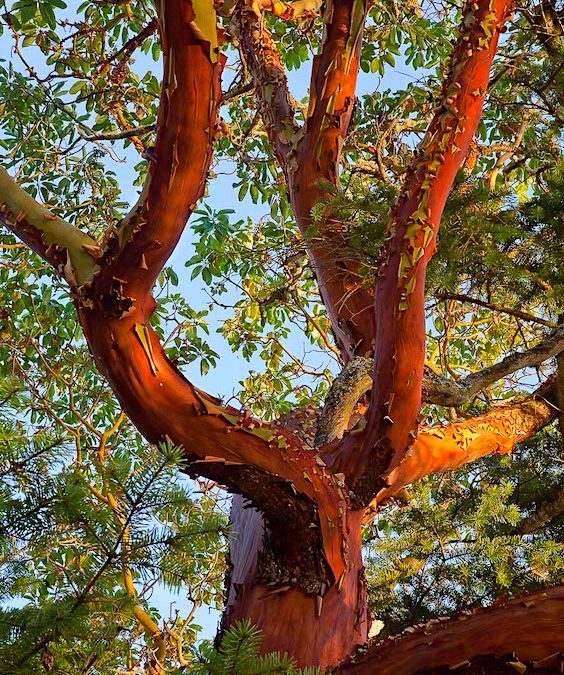“The strongest tree in the forest is not the one that is protected from the storm and hidden from the sun. It’s the one that stands in the open where it is compelled to struggle for its existence against the winds and rains and the scorching sun.” –Napoleon Hill
Throughout our lives, we will inevitably move through challenges in which we question everything it was that we knew up until that point. These challenges can come forth as if from out of thin air and upset our equilibrium when they do.
Many of us are feeling it. Without a doubt, we are living in a time where we are witnessing unparalleled violence and trauma worldwide. But what’s the effect on all of us watching from home?
In this blog, I’m taking a closer look at the quality of resilience and how we can cultivate it for our wellbeing when faced with traumatic stress and the tragedies of life.
Traumatic Stress
Traumatic stress is a normal reaction to an abnormal event in which a person has difficulty recovering after experiencing or witnessing a terrifying event.
June brings national awareness of PTSD – Post-traumatic stress disorder. Initially, people involved in combat, victims of violent physical, sexual, or verbal assault and accidents, suffer various degrees of anxiety, poor sleep, depression, withdrawal, and isolation without being diagnosed.
Sometimes the signs of distress occur immediately, and sometimes the cumulative effects can be delayed—even by years. Many people recover from PTSD after a few days, weeks, or months. Yet, for others, recovery might mean a lot longer.
Over the past few years, we have faced an onslaught from the pandemic, the fallout from political misinformation, social and civil unrest, police brutality, unimaginable gun violence, the assault on women’s rights, horrors of war, devastating climatic events, etc.
While directly experiencing violent events in person is traumatic, we’ve seen an uptick in stress-producing violence and worldwide disasters in the last few years. We watch the world’s tragedies unfold in real-time.
But did you know that simply witnessing traumatic events directly or indirectly from a distance via cell phones, tablets, and TV screens gets processed by the brain and nervous system much in the same way?
Witnessing these kinds of events can be disturbing enough to lead to distressing thoughts, anxiety, feelings of sadness, fear, and hopelessness or helplessness. Some may experience physical symptoms, including headaches and stomachaches impairing daily functioning.
I don’t believe that any of us is spared the sadness, fear, and stress these events provoke. It’s wearisome.
And, if you are like me, you also yearn to find a world at peace with each other. To successfully navigate traumatic stress, our survival as human beings must explore and develop ways of de-stressing and building support. Hence, we become resilient to bounce back and move forward collectively for our children’s sake.
What is it Going to Take?
Though many variables are out of our control, there are steps we can take, both individually and collectively, to help ourselves process stress and trauma and improve our ability to recover.
The Resilience of the Human Spirit is Extraordinary
We, humans, are incredibly resilient. We have an extraordinary ability to work through the stress elicited by traumatic experiences we witness. We can withstand adversity, rebound, and grow stronger despite life’s downturns.
And we are not helpless. Resilience is not a passive process — it’s a dynamic process, changing over time in response to various life experiences. It is both a cultivated process of perspective and an outcome because the ability to cope under adverse circumstances partly results from the experience of living through difficult experiences.
Many people find solace in the spirit of human resilience even as the polarity of the old paradigm strives to stay in control. It reflects our ability to successfully adapt in the face of stress, challenge, and adversity. It allows us to cope with challenges with greater clarity and inner strength.
Resilience to draw upon inner strength to grow through the extremes of life’s obstacles brings out the best of the human spirit. Resilient people not only survive after a setback, but they also come back stronger and wiser.
We can enhance our resilience by taking advantage of the vibrational essences that carry nature signatures to help us.
The Doctrine of Signatures
The “doctrine of signatures” embraces the concept that plants resemble an energetic hologram. People have used a plant’s appearance for thousands of years to perceive its therapeutic properties.
The physical characteristics of a plant, flower, and other elements used in making a vibrational essence can provide revealing information about its qualities. Looking closely and observing a plant’s form, shape, color, texture, scent, and environmental location and habitat, we can learn the plant’s indicators of its personality, sympathetic nature, energy systems, and possible relationship to human body systems.
The doctrine of signatures orients its treatment protocols around the principle of “like-treats-like.” This is the foundation for Homeopathy, flower essence, and vibrational therapies.
Nature’s healing signatures can help restore balance. We can gain insight into the properties of plants, how they may be supportive to humans, and even glimpse an understanding that all things are connected and present in relationship to one another.
The Majestic Pacific Madrone
Looking through the lens of energetic signatures, we can learn much from the Majestic Pacific Madrone (Arbutus menziesii) and how it may help us become more resilient.
The Madrone is endemic to the Pacific coast. Growing on the edge of land and sea, in rough and rocky conditions, thrown and tossed by the winds, they are survivors in the wild. Pacific madrones are not uncommon to live 400 years, and many grow to over 100 feet tall.
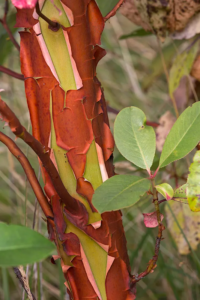 Madrone is an important tree in the Pacific Northwest because of its cultural and ecological value. Though it looks exotic with its distinctive red peeling bark, this beautiful broadleaf evergreen tree has a captivating and distinctive presence that transforms with the seasons.
Madrone is an important tree in the Pacific Northwest because of its cultural and ecological value. Though it looks exotic with its distinctive red peeling bark, this beautiful broadleaf evergreen tree has a captivating and distinctive presence that transforms with the seasons.
Madrone Trees are Resilient
Madrone trees love the sun. They will twist and turn to find it if a competing tree tries to outgrow it. If blown over in a storm, they will still grow due to the tenaciousness of their roots.
Under natural conditions, Madrone depends on intermittent fires that limit the conifer overstory (typically Douglas-fir trees). Due to carbohydrate reserves within existing roots, older trees can survive fire and sprout quickly and profusely afterward.
Its exquisite feminine attributes, fragrant flower clusters, brilliant berries, glossy leaves, twisting branches, rounded crown, and rich cinnamon-red bark peels from a satin-smooth trunk please all our senses. Its ecological gifts are plentiful. It abounds with white blossoms during the spring and early summer months.
Salish indigenous people in the Northwest revere the Madrone and see it as the most sacred tree in their habitat. They say, “The tree’s webbed roots hold the splintered earth together.”
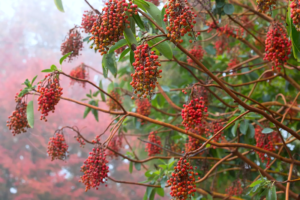 The people used the tree’s berries as food, fishing bait, and medicinal purposes. The tree’s leaves provided a traditional cure for cramps, skin sores, stomach aches, and other illnesses.
The people used the tree’s berries as food, fishing bait, and medicinal purposes. The tree’s leaves provided a traditional cure for cramps, skin sores, stomach aches, and other illnesses.
To the Salish people, the Madrone symbolized the balance between light and dark, protection and safety, determination and survival, generously giving its many gifts.
This magnificent tree carries the energy signature of resilience and perseverance. It imparts the strength, beauty, and exceptionality of the human spirit to live fully and recover from adversity.
Resilience Ritual Essence
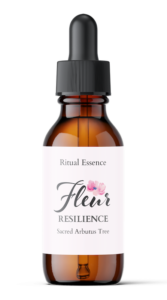 The vibrational energy source of Resilience Ritual Essence was made along the Oregon coast at the base of the majestic Pacific Madrone tree.
The vibrational energy source of Resilience Ritual Essence was made along the Oregon coast at the base of the majestic Pacific Madrone tree.
Resilience Ritual Essence can bring comfort in times of distress, trauma, or emotional upset. It also helps release the effects of shock or fright that, if left unresolved, may become the underlying cause of future imbalances.
Using vibrational essences such as Resilience Ritual Essence will help you bounce back from significant sources of stress, trauma, adversity, tragedy, and threats to recover from setbacks much faster.
Use Resilience Ritual Essence to
- De-stress from witnessing traumatic events.
- Create a buffer for continued thoughts and images of the event.
- Overcome the challenges of PTSD.
- Get through the pain and disappointment to carry on.
- Strengthen deep energetic roots of inner support as a buffer against stress.
- Cope with sadness and helplessness.
- Anchor your ability to bounce back amid suffering.
- Keep your face turned toward the light to find your way.
- Maintain perspective to sustain an optimistic outlook.
- Shed emotional layers holding you splintered and stuck in fear.
- Gather your inner resources to rise from the ashes after adversity.
- Navigate the unexpected twists and turns in your life that suddenly occurs.
- Soothe yourself in emotional safety and security.
- Re-establish a sense of internal control and perseverance.
- Adapt to life’s misfortunes.
- Activate compassion and understanding.
- Enhance self-care practices.
- Recover from hardship.
- Protect yourself from burnout from informational media overload.
- Bounce back when you stumble through the trials and troubles of life.
Resilience in Connection
“Be kind, for everyone you meet is fighting a hard battle.” –Plato
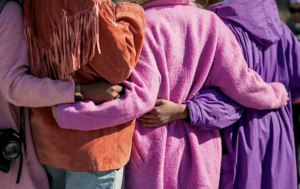 Of course, we bounce back faster through human connection and care. We need to know that we matter no matter how lost, broken, or alone we may feel. Building solid and positive relationships with loved ones and friends you can confide in, provide you with needed support, guidance, and acceptance in good and bad times.
Of course, we bounce back faster through human connection and care. We need to know that we matter no matter how lost, broken, or alone we may feel. Building solid and positive relationships with loved ones and friends you can confide in, provide you with needed support, guidance, and acceptance in good and bad times.
Resilience won’t make our stressful problems disappear, but cultivating resilience can allow you to find the inner strength to see past them, enjoy life, and handle traumatic stress.
Although it can take time to recover from a significant setback, traumatic event, or loss, we must also cultivate optimism and hope that our situation can improve and the world can become kinder. By restoring a sense of safety, acknowledging our feelings, and helping survivors to discover and draw on their resilient spirits, we can find comfort in each other’s presence.
We can bounce back and flourish by availing ourselves of the Madrone’s gifts in times of traumatic stress. We can tap into the human spirit of resilience as we come together. Our resilient efforts will reward our future.
All my aromatic love,
Vidya

